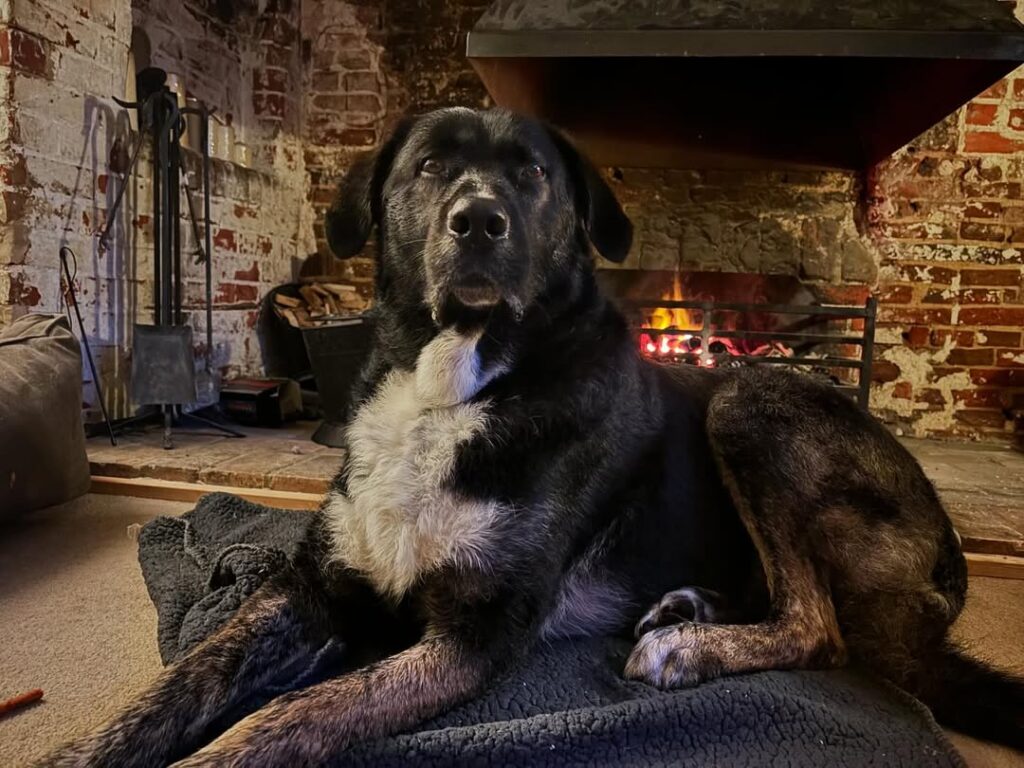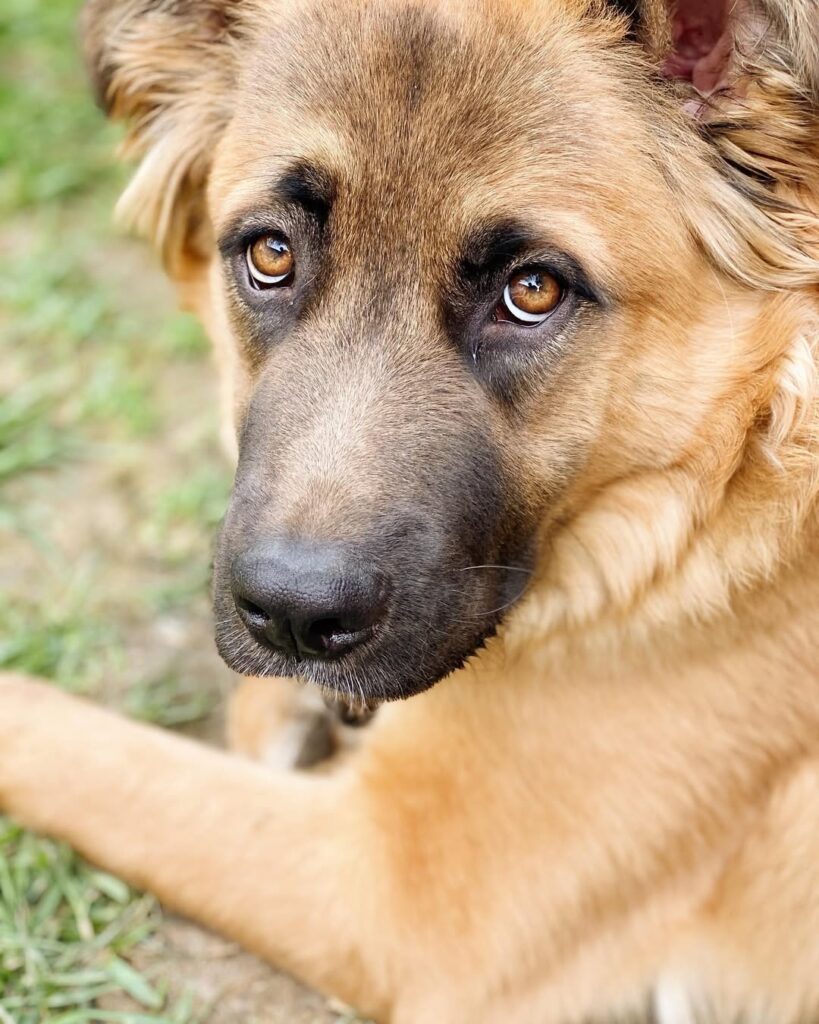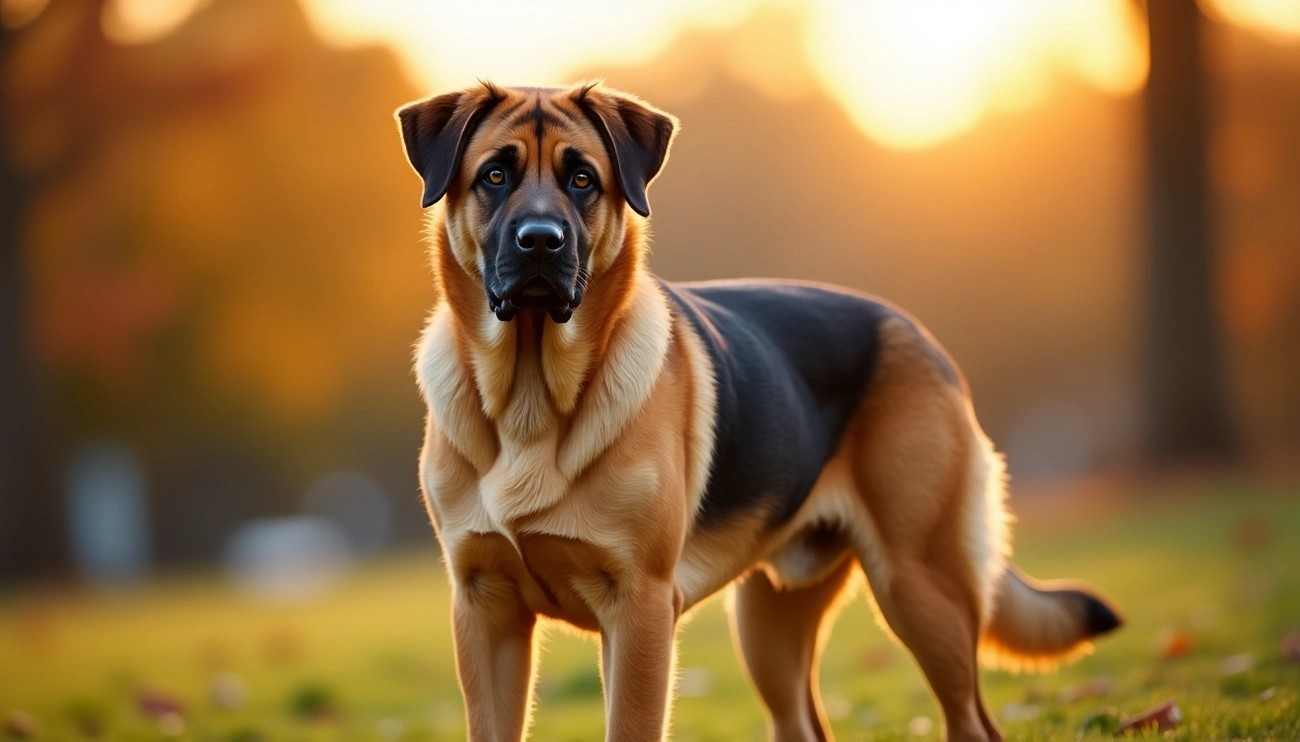The German Shepherd Mastiff mix combines two strong breeds to create an impressive dog that can reach 30 inches in height at the shoulder. This huge breed has been around since the 19th century mixing the German Shepherd’s smarts with the Mastiff’s kind temperament. But their massive size has its own challenges and needs special care that might not suit every owner. These dogs can weigh as much as 200 pounds.
When grown, a German Shepherd Mastiff mix needs between 1 and 2 hours of exercise every day to stay healthy in both body and mind. These dogs are loyal and protective, but they can face several health issues like hip dysplasia, bloat, and obesity. These problems may have a serious effect on their overall health. Training them is very important because their size and specific care needs make them a poor fit for first-time dog owners. Before adopting one, ask yourself if you have the time, space, and commitment to take care of this incredible yet challenging breed. They live 9 to 12 years.
History and Origin of the German Shepherd Mastiff Mix
“Anonymous, a dog lover quoted in a canine magazine once compared the German Shepherd to other dogs, saying it’s what the lion is to the cat.
To understand the story of the German Shepherd Mastiff mix, you need to look at the two parent breeds. Both have unique legacies shaped by generations of selective pairing and intentional growth. The history of German Shepherds…”
The story of the German Shepherd began when Max von Stephanitz, a former cavalry officer and student at Berlin Veterinary College, discovered a dog named Hektor Linksrhein at a dog show. He admired the dog’s sharp intelligence and wolf-like looks. Without hesitation, von Stephanitz bought the dog and gave him the new name Horand von Grafrath. Just weeks later, he established the first German Shepherd Dog Club and made Horand the first official German Shepherd, assigning him registration number SZ1 in 1899.
Von Stephanitz focused on creating a dog with a purpose instead of just breeding an animal for appearance. He followed the motto “Utility and intelligence” to shape his breeding methods. These dogs were made to herd sheep across the rural landscapes of Germany. They required sharp senses, quick movements, strength, and the ability to think. Von Stephanitz picked and bred dogs to establish the standard for the breed. After World War I, this breed gained fame worldwide.
The story of Mastiffs
Mastiffs rank among the oldest dog breeds, with their roots tracing back thousands of years. Archaeologists have found evidence of large, mastiff-like dogs roaming Asia’s mountains long ago. Ancient Assyrian carvings show these massive dogs hunting lions by the Tigris River, going as far back as 2500 BC.
Their exact beginnings remain somewhat unclear, but history shows the Romans became fascinated with British Mastiffs during their invasions. They transported some to Italy where they were used in Coliseum fights. Over time different societies relied on Mastiffs as war dogs, hunters, and protectors.
People developed the modern Mastiff in Britain, keeping the breed as pure as possible. The Lyme Hall line, started in the early 1400s, holds the title of the oldest Mastiff kennel in history. After the World Wars wiped out the breed, breeders in North America stepped in to rebuild Mastiff numbers by sending dogs back to Britain to breed.
How this mix began
The German Shepherd Mastiff mix brings together two breeds with working roots, but they excel at very different tasks. While this mix has been around since the 1800s, it never reached the fame of other crossbreeds. Nobody knows when breeders first began crossing German Shepherds with Mastiffs on purpose.
This blend stands out because it combines strengths from both breeds. The German Shepherd brings loyalty, intelligence, and adaptability. The Mastiff contributes its calm personality, protective nature, and impressive build. Over the years, breeders have admired how the Shepherd’s alertness and ease of training pair with the Mastiff’s steady and confident demeanor.
Breeders aim to develop a dog that shows the Shepherd’s hard-working traits alongside the Mastiff’s strong and commanding presence. The result is a companion that carries protective instincts from both sides, mixing the Shepherd’s watchful nature with the Mastiff’s guardian-like tendencies.
German Shepherd Mastiff mixes do not follow the same strict standards as purebred dogs, but they inherit a long history of being chosen to be smart, loyal, and protective. These traits come from both parent breeds, making them loyal pets with a remarkable background.
What to Know About Their Looks and Size

When you first meet a grown German Shepherd Mastiff mix, their size grabs your attention right away. This strong hybrid combines the lean athletic frame of a German Shepherd with the heavy build of a Mastiff. The result is a dog that stands out wherever it goes.
Average size and weight
The German Shepherd Mastiff mix is one of the biggest crossbreeds you can find. Males are taller than females, and their height ranges between 22 and 30 inches at the shoulder. Some might even grow taller depending on which parent breed has a stronger genetic influence.
Weight differences in this breed are very noticeable. These dogs weigh somewhere between 65 and 200 pounds, with males and females showing big differences. The Mastiff genes play a big role in this. Male purebred Mastiffs weigh around 160-230 pounds, while females tend to be lighter, between 120-170 pounds.
One expert gives a narrower weight range of 130-190 pounds, but everyone agrees this breed is classified as a giant breed. To compare, German Shepherds weigh about 88 pounds (40 kg). Even the lightest German Shepherd Mastiff mix will weigh far more than its German Shepherd parent.
Coat types and common colors
The type of coat your German Shepherd Mastiff mix has will be influenced by which parent’s genes are stronger. Since both parent breeds have double coats, your dog will have one too, no matter which side they take after more.
Their coat might fall somewhere between the German Shepherd’s medium double coat and the Mastiff’s short, thicker coat. Dogs leaning more toward their German Shepherd side often have fluffier fur, especially around the neck and shoulders. On the other hand, mixes that are closer to the Mastiff side tend to have shorter, more even fur.
When it comes to coat colors, you’ll see a range of common patterns.
- Black and tan (the usual German Shepherd look)
- Fawn or apricot (common Mastiff shades)
- Brindle (striped patterns, not as frequent)
- Mixed tones like sandy silver (a mix of gray and brown)
Shedding can depend on their genetics. German Shepherds tend to shed a lot during certain seasons, so dogs that resemble them might need extra grooming. On the other hand, dogs that are more like Mastiffs often shed less.
Appearance of an adult German Shepherd Mastiff mix

A full-grown German Shepherd Mastiff mix strikes an impressive figure, blending key traits from both its parent breeds. These dogs have a strong and muscular frame, which hints at their working background.
, no two German Shepherd Mastiff mixes look the same. Even littermates might look very different. One pup could lean more toward the Mastiff’s features, while another might look more like a German Shepherd. Still, their size and structure stay within certain expected ranges.
Their head often shows a mix of traits from both breeds. It combines the sharp alert look of the German Shepherd with the Mastiff’s larger and sturdier skull shape. Their ears can either stand upright like a German Shepherd’s or fold forward, depending on their genes.
This mix stands out because it combines the best traits of both parent breeds. The German Shepherd contributes a strong athletic body, while the Mastiff adds size and an intimidating presence. Together, they create a dog that looks both strong and graceful. This breed can excel as both a protector and a loyal companion.
Temperament and Behavior Traits
“To own a German Shepherd, you must be smarter than a German Shepherd.” —Anonymous German Shepherd owner quoted in dog publication
Beneath the striking looks of the German Shepherd Mastiff mix lies a personality shaped by both parent breeds. To care for this impressive hybrid, owners need to understand the mix of traits it inherits. General personality overview is key to grasp.
The German Shepherd Mastiff mix gets its loyal and protective traits from both parent breeds. People often call these dogs gentle giants. They are strong but love being close to their families. Keep in mind, though, their personalities can differ a lot from one pup to another since behavior depends on more than just breed. These dogs often combine the German Shepherd’s alert nature with the Mastiff’s calm, patient, making them both vigilant and laid-back, 9% of their behavior.
This breed shows a mix of intelligence and willingness to learn, pulling curiosity from the German Shepherd and a friendly vibe from the Mastiff. Most, they bond with their families. They enjoy human interaction and love being part of family events, making them loyal and happy companions.
How they interact with kids and other pets
German Shepherd Mastiff mixes show kindness and affection toward kids. They have a calm and easygoing personality that helps them fit in as a family pet if they receive proper training. These dogs tend to have a strong instinct to protect, which often makes them careful and watchful around small children.
Their behavior with other animals can vary from dog to dog. Some may act territorial or unfriendly with other dogs, while others may be quite social. Dogs that grow up around cats or other pets as puppies are often more likely to live with them.
Training and socializing requirements
Starting and staying consistent with training is key to guiding this breed. Without clear rules, these strong dogs could try to take control, making them hard to handle. Use rewards like special treats, toys, or verbal praise, depending on what your dog responds to best, to keep training positive.
You need to introduce socialization from an early age and keep it going throughout their lives. It’s not something they can learn once and be don withe. They need exposure to new people, animals, and settings to avoid protective tendencies turning into unnecessary aggression.
Common behavior struggles
Even with their many good traits, German Shepherd Mastiff mixes may face some behavioral problems. Their deep attachment to family members often leads to separation anxiety when left alone. At the same time, without proper socialization, their protective nature can cause issues like aggression toward unfamiliar people.
Certain mixes take on a stubborn streak often from their Mastiff lineage, which can make training harder at times. Their large size paired with habits like leash pulling, might also pose challenges to owners who are not ready for it.
Health, Life Expectancy, and Typical Problems
Looking after a German Shepherd Mastiff mix means knowing about their health needs, as this can influence how long they live and the kind of life they lead. Being a big crossbreed, they deal with unique difficulties that knowledgeable owners should be ready to handle.
Lifespan of the German Shepherd Mastiff mix
German Shepherd Mastiff mixes live about 9 to 13 years. Some say the range might stretch from 6 to 14 years. Genetics, diet, exercise, and healthcare all play a role in how long they’ll stick around. These big dogs take longer to grow up than smaller breeds, but they seem to get old faster once they’re adults.
Purebred German Shepherds live about 7 to 10 years. In comparison, this mix often has a longer life expectancy. Mastiff Shepherds hit their senior years at around 7. You might notice gray hairs near their muzzle and lower energy by then.
Health risks to be aware of
Both parent breeds pass along possible health problems to this mix. Some of the most frequent issues are:
Hip and elbow dysplasia, which shows up in about 19.8% of German Shepherds, is a significant concern in this mix too. It results from abnormal joint growth and can cause pain, arthritis, and trouble moving as the condition progresses.
Bloat, also called Gastric Torsion, poses a serious risk to dogs with deep chests. This dangerous issue happens when gas fills the stomach, causing it to twist. Immediate help from a vet is needed to treat it.
Other health risks worth mentioning include:
- Heart issues
- Eye conditions like cherry eye
- Degenerative myelopathy
- Allergies
- Cancer hemangiosarcoma and osteosarcoma
- Epilepsy
Health check-ups and preventive care
Routine vet visits play a big role in keeping your German Shepherd Mastiff mix healthy. Schedule yearly check-ups that include physical exams, blood tests, and X-rays as your dog gets older.
For dogs aged seven and above, visiting the vet twice a year becomes more important. These visits allow early spotting of problems when treatments work better and often cost less. Preventive care should also include the following:
- Staying up-to-date with vaccinations
- Providing parasite prevention year-round
- Caring for teeth to avoid health complications
- Spaying or neutering lowers the chance of certain cancers
Warning signs of obesity and joint trouble
This breed tends to struggle with obesity, which harms joints and shortens lifespan. Look out for a missing waistline, trouble feeling ribs, or reduced stamina during activity.
Extra weight hurts overall health. It makes conditions like diabetes, kidney issues, high blood pressure, and breathing difficulties more likely. It also adds pressure to joints that may already have problems.
Joint problems can start showing subtle hints long before they become clear. Pay attention to these early indicators:
- Feeling stiff after sleeping or resting
- Hesitating to jump or go upstairs
- Walking with a limp or putting more weight on one leg
- Being less active than usual
Helping your German Shepherd Mastiff mix keep a healthy weight by feeding them right and exercising is one of the best ways to take care of their joints.
Everyday Care, Grooming, and Exercise

Your German Shepherd Mastiff mix needs good care every single day to stay healthy and happy. You can keep your big dog in good shape by focusing on exercise, mental challenges, grooming, and the right food.
Exercise needs by age
These strong breeds need activities suited to their age. grown German Shepherd Mastiff mixes need one to two hours of exercise each day. For puppies, stick to the five-minute-per-month rule—five minutes of activity per month of age, done twice a day. This helps avoid joint problems as they grow.
As your dog gets older, try including activities like:
- Going on regular walks at a steady pace
- Swimming to give them exercise that’s easy on their joints
- Spending time playing in safe fenced spaces
- Mixing training with some mental challenges and physical movement
Older dogs stay healthier and more mobile with exercise sessions that happen more often but last for less time. This approach helps their aging joints avoid stress while keeping them active.
Stimulating their minds and keeping them engaged
Keeping this smart breed active is as important as getting their body moving. Adult dogs need around 20 to 40 minutes of mental exercises a day, while puppies need about 5 to 15 minutes. If their minds are bored or ignored, they may start chewing on stuff, barking too much, or digging holes where they shouldn’t.
Engaging their minds can be done in different ways. Puzzle toys stuffed with treats, activities like sniffing games to use their strong sense of smell, and training tasks that make them think are great options. Playing hide-and-seek also gives them both a brain workout and a chance to move around.
Grooming routines to match various coat types
Use a slicker brush or undercoat rake to brush your German Shepherd Mastiff mix two to three times a week. In spring and fall, brushing every day helps you control loose fur during shedding. Do not shave their double coat, as it protects them from both hot and cold weather.
Bathe them every four to six weeks with shampoo made for dogs so their natural oils stay intact. Check their ears and clean them once a week. Trim their nails every three to four weeks. Brush their teeth often to give them proper care.
Tips on feeding and nutrition
Feed food designed for large breeds and make sure it is high-quality. Puppies need puppy food made for their breed to grow the right way. To avoid bloat, which can be very dangerous, break their daily food into smaller meals instead of one big meal. Talk to your vet to figure out the exact portions based on your dog’s size, age, and activity.
Conclusion
German Shepherd Mastiff mixes are hard to miss with their big size and the blend of traits from their impressive parent breeds. These massive dogs are loyal, protective, and smart, making them great companions for dog lovers. However, owning one means understanding their unique needs and thinking carefully about them before deciding to welcome one into your life.
Responsible ownership begins with realizing how much time and effort these dogs need. Their large size brings challenges. Transporting them is hard. Food, supplies, and medicine cost more. They need 1 to 2 hours of daily exercise. Skipping this can lead to joint problems.
Owners must stay alert to health issues like hip dysplasia, bloat, and obesity. These concerns stick around through their 9-to-13-year lifespan. Grooming is simple with regular brushing, but it gets trickier when they shed more in certain seasons. They are protective by nature. and steady socialization helps them behave better around strangers.
In the end, the German Shepherd Mastiff mix offers loyal companionship to owners who commit to their care. These unique dogs do best with owners who understand their strong abilities but also recognize their challenges. Before bringing one into your home, think about your space, time, and experience to see if you can give these big dogs the right conditions to thrive.
FAQs
Q1. How large do German Shepherd Mastiff mixes get?
These dogs are quite big, with weights ranging from 65 to over 200 pounds and heights between 22 and over 30 inches at the shoulder. Males tend to be bigger than females, with some even standing taller than 3 feet.
Q2. What is the temperament of a German Shepherd Mastiff mix like?
German Shepherd Mastiff mixes show loyalty, protectiveness, and love toward their families. They are smart and willing to learn but may act stubborn sometimes. Early socialization helps them behave well around kids and other animals.
Q3. How much exercise does a German Shepherd Mastiff mix need?
German Shepherd Mastiff mixes need one to two hours of physical activity every day. This should include things like walking, playing, and activities to challenge their minds. The amount of exercise depends on the dog’s age and its energy level.
Q4. What are some common health issues to consider in German Shepherd Mastiff mixes?
Some common health problems include hip and elbow dysplasia, heart issues, bloat, and eye disorders. They can also gain too much weight, which puts extra strain on their joints. Taking them to the vet and keeping their weight in check helps them stay healthy.
Q5. How long do German Shepherd Mastiff mixes live?
German Shepherd Mastiff mixes live around 9 to 13 years. Giving them good care with proper food enough exercise, and preventive healthcare helps them stay healthy and live longer.
